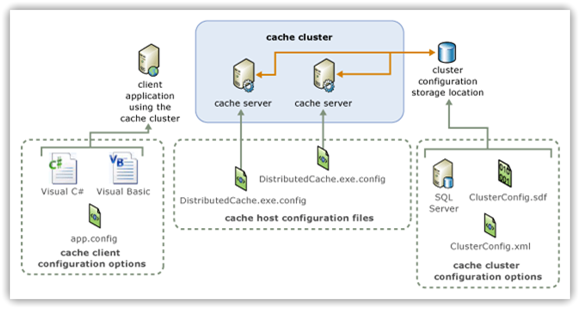使用微软分布式缓存服务Velocity Part 2
概述
Velocity是微软推出的分布式缓存解决方案,为开发可扩展性,可用的,高性能的应用程提供支持,可以缓存各种类型的数据,如CLR对象、XML、二进制数据等,并且支持集群模式的缓存服务器。Velocity也将集成在.NET Framework 4.0中,本文将介绍Velocity中的配置模型、缓存复杂数据和创建分区、使用标签以及ASP.NET SessionState提供者。
配置模型
在本文开始之前,先简单介绍一下Velocity中的配置模型,主要包括三方面的配置,缓存集群的配置,缓存宿主服务器配置以及应用程序的配置,如下图所示:

缓存集群的配置,可以基于XML、SQL Server CE或者SQL Server数据库来进行存储,包括各个服务器以及所有的命名缓存、是否过期等配置,当我们使用Windows PowerShell管理工具进行配置时,将会修改该配置文件,如下代码所示:
<?xml version="1.0" encoding="utf-8"?> <configuration> <configSections> <section name="dcache" type="System.Data.Caching.DCacheSection, CacheBaseLibrary, Version=1.0.0.0, Culture=neutral, PublicKeyToken=89845dcd8080cc91" /> </configSections> <dcache cluster="localhost" size="Small"> <caches> <cache type="partitioned" consistency="strong" name="default"> <policy> <eviction type="lru" /> <expiration defaultTTL="10" isExpirable="true" /> </policy> </cache> <cache type="partitioned" consistency="strong" name="other"> <policy> <eviction type="lru" /> <expiration defaultTTL="10" isExpirable="true" /> </policy> </cache> </caches> <hosts> <host clusterPort="22234" hostId="1319514812" size="1024" quorumHost="true" name="TERRYLEE-PC" cacheHostName="DistributedCacheService" cachePort="22233" /> </hosts> <advancedProperties> <partitionStoreConnectionSettings providerName="System.Data.SqlServerCe.3.5" connectionString="D:\CacheShare\ConfigStore.sdf" /> </advancedProperties> </dcache> </configuration>
在上一篇的示例中,并没有使用应用程序配置文件,事实上使用配置文件是更好的编程实践,首先需要添加一个配置区:
<section name="dcacheClient" type="System.Data.Caching.DCacheSection, CacheBaseLibrary, Version=1.0.0.0, Culture=neutral, PublicKeyToken=89845dcd8080cc91"/>
配置信息包括部署方式,是否启用本地缓存以及缓存宿主等,如下代码所示:
<dcacheClient> <localCache isEnabled="true" sync="TTLBased" ttlValue="300" /> <hosts> <host name="localhost" cachePort="22233" cacheHostName="DistributedCacheService"/> </hosts> </dcacheClient>
现在Velocity CTP2对于应用程序使用配置的支持似乎有些问题。缓存宿主的配置放在DistributedCache.exe.config文件中,可以在Velocity安装目录下找到。
缓存复杂数据类型
在Velocity中,可以缓存任何类型的数据,如CLR对象、XML或者二进制数据等。现在看一个简单的示例,如何缓存复杂类型数据,定义一个如下的Customer类,注意要能够序列化:
[Serializable] public class Customer { public String ID { get; set; } public String FirstName { get; set; } public String LastName { get; set; } public int Age { get; set; } public String Email { get; set; } }
对应用程序做配置,参考本文的配置模型部分,使用方法与简单数据类型的基本一致,如添加缓存项,使用Customer主键作为缓存键,其中GetCurrentCache()方法的实现请参考上一篇文章:
Cache cache = GetCurrentCache(); Customer customer = new Customer() { ID = "C20081117002", FirstName = "Terry", LastName = "Lee", Age = 25, Email = "lhj_cauc[#AT#]163.com" }; cache.Add(customer.ID, customer);
获取缓存项:
Cache cache = GetCurrentCache(); Customer customer = cache.Get("C20081117002") as Customer;
移除缓存项:
Cache cache = GetCurrentCache(); cache.Remove("C20081117002");
更新缓存中数据,可以有两种方法,一是直接使用缓存索引,如果确保缓存键存在:
Cache cache = GetCurrentCache(); Customer customer = new Customer() { ID = "C20081117002", FirstName = "Huijui", LastName = "Li", Age = 26, Email = "lhj_cauc[#AT#]163.com" }; cache["C20081117002"] = customer;
另外一种是使用Put方法,如果缓存键不存在,它将会新增到缓存中,否则会进行覆盖,如下代码所示:
Cache cache = GetCurrentCache(); Customer customer = new Customer() { ID = "C20081117002", FirstName = "Huijui", LastName = "Li", Age = 26, Email = "lhj_cauc[#AT#]163.com" }; cache.Put(customer.ID, customer);
使用分区
在实际部署中,经常会出现多个应用程序共享同一个缓存集群,这不可避免的会出现缓存键冲突,如上面的示例中使用CustomerID作为缓存键,此时可以使用Velocity中的分区功能,它会在逻辑上把各个命名缓存再进行分区,这样可以完全保持数据隔离,如下图所示:

图中共有三个命名缓存,其中在缓存Catalog中又分区为Sports和Arts。在Velocity中对于分区的操作提供了如下三个方法,可以用于创建分区,删除分区以及清空分区中所有的对象:
public void ClearRegion(string region); public bool CreateRegion(string region, bool evictable); public bool RemoveRegion(string region);
如下代码所示,创建了一个名为“Customers”的分区,在调用Add方法时可以指定数据将会缓存到哪个分区:
Cache cache = GetCurrentCache(); string regionName = "Customers"; cache.CreateRegion(regionName, false); Customer customer = new Customer() { ID = "C20081117003", FirstName = "Terry", LastName = "Lee", Age = 25, Email = "lhj_cauc[#AT#]163.com" }; cache.Add(regionName, customer.ID, customer);
可以使用Get-CacheRegion命令在Windows PowerShell中来查看一下当前缓存集群中所有的分区信息,如下图所示:

同样在检索缓存数据时,仍然可以使用分区名进行检索。
使用标签
在Velocity还允许对加入到缓存中的缓存项设置Tag,可以是一个或者多个,使用了Tag,就可以从多个方面对缓存项进行描述,这样在检索数据时,就可以根据Tag来一次检索多个缓存项。为缓存项设置Tag,如下代码所示:
Cache cache = GetCurrentCache(); string regionName = "Customers"; Customer customer1 = new Customer() { ID = "C20081117004", FirstName = "Terry", LastName = "Lee", Age = 25, Email = "lhj_cauc[#AT#]163.com" }; Customer customer2 = new Customer() { ID = "C20081117005", FirstName = "Terry", LastName = "Lee", Age = 25, Email = "lhj_cauc[#AT#]163.com" }; Tag tag1 = new Tag("Beijing"); Tag tag2 = new Tag("Tianjin"); cache.Add(regionName, customer1.ID, customer1, new Tag[] { tag1, tag2 }); cache.Add(regionName, customer2.ID, customer2, new Tag[] { tag2 });
这样就可以对设置了Tag的缓存项进行检索,根据实际需求选择使用如下三个方法之一:
GetAllMatchingTags(string region, Tag[] tags) GetAnyMatchingTag(string region, Tag[] tags) GetByTag(string region, Tag tag)
第一个检索匹配所有Tag的数据,第二个检索匹配所有Tag中的任意一个即可,最后只使用一个Tag,如下代码所示:
string regionName = "Customers"; Tag[] tags = new Tag[] { new Tag("Beijing"), new Tag("Tianjin")}; List<KeyValuePair<string, object>> result = cache.GetAllMatchingTags(regionName, tags);
使用Tag功能对于检索缓存项提供了极大的灵活性,对于任何一个数据,都可以使用多个Tag从很多方面去描述它。
ASP.NET SessionState提供者
Velocity还提供了对于ASP.NET SessionState提供者的支持,可以通过配置把Session信息缓存到缓存集群中,添加Velocity配置区:
<section name="dcacheClient" type="System.Data.Caching.DCacheSection, CacheBaseLibrary, Version=1.0.0.0, Culture=neutral, PublicKeyToken=89845dcd8080cc91"/>
配置缓存客户端信息:
<dcacheClient> <localCache isEnabled="true" sync="TTLBased" ttlValue="300" /> <hosts> <host name="localhost" cachePort="22233" cacheHostName="DistributedCacheService"/> </hosts> </dcacheClient>
配置SessionState信息:
<sessionState mode="Custom" customProvider="Velocity"> <providers> <add name="Velocity" type="System.Data.Caching.SessionStoreProvider,ClientLibrary" cacheName="default"/> </providers> </sessionState>
需要指定使用哪个命名缓存,但是该功能似乎到目前还存在问题,无法测试通过L
总结
本文简单介绍了Velocity的配置模型,以及如何缓存复杂数据类型,对命名缓存分区,为缓存项设置Tag,以及对于ASP.NET SessionState的支持,希望对大家有用。
相关文章:
Worktile,新一代简单好用、体验极致的团队协同、项目管理工具,让你和你的团队随时随地一起工作。完全免费,现在就去了解一下吧。
https://worktile.com

 Velocity是微软推出的分布式缓存解决方案,为开发可扩展性,可用的,高性能的应用程提供支持,可以缓存各种类型的数据,如CLR对象、XML、二进制数据等,并且支持集群模式的缓存服务器。Velocity也将集成在.NET Framework 4.0中,本文将介绍Velocity中的配置模型、缓存复杂数据和创建分区、使用标签以及ASP.NET SessionState提供者。
Velocity是微软推出的分布式缓存解决方案,为开发可扩展性,可用的,高性能的应用程提供支持,可以缓存各种类型的数据,如CLR对象、XML、二进制数据等,并且支持集群模式的缓存服务器。Velocity也将集成在.NET Framework 4.0中,本文将介绍Velocity中的配置模型、缓存复杂数据和创建分区、使用标签以及ASP.NET SessionState提供者。
